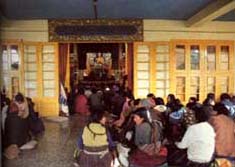|
|

|
|

|
The essence of Buddhism lies in the four Noble truths: (Sanketas) i.e. suffering; its cause; its cessation and the path leading to the cessation of suffering. The eight fold path leading to the removal of suffering consists of right conduct, right motive, right resolve , right speech, right livelihood, right attention, right effort and right meditation. Following this path one can conquer his cravings for worldly things. The Buddha held that, the 'mind' is the nerve centre of every human activity. In Buddhism, therefore, Vipasana, (meditation) is more important than the prayer and various abstinences which border upon asceticism. By controlling his mind and conquering his cravings, one can hope to attain 'Nirvana'; the state of complete peace.
The three characteristics of Buddhism are : Anicca (transiency), Dukkha (sorrow) and Anatta (soul-lessness). In other words, life is constantly changing and all conditioned things are transient. Whatever is transient, is painful, and where change and sorrow prevail, the question of a permanent immortal soul does not arise. He did not accept that there was an immortal entity which survived the death of the body and was born in other forms through a series of incarnation. Nevertheless the principle of Sansara wandering (rebirth) was accepted by the Buddha.
A Buddhist is a person who reveres the Buddha, as the highest spiritual guide and strives to live according to his teachings. A person taking refuge in the Triple-Gem (Tri-Ratana) not only reveres the Buddha but also undertake to practice Dhamma in his daily life and to support the Bhikkhu-Sangha. Three refuges are followed by the five Moral precepts (Pancha Sila) which form the bed rock of the Buddhist way of life. They are, to abstain from killing, stealing, adultery, lying and intoxications. The refuge -cum-precepts formula is recited in Pali by the devout Buddhists daily in the morning as well as in the evening and at all religious ceremonies and social functions.
The Buddhist are divided into two
classes i.e. the Upasakas and the monks. The term Upasaka is a lay devotee,
or a lay follower who has taken refuge in the Buddha, Dhamma and the Sangha.
Those who renounce the life of a recluse by joining the Sangha are known as
monks (bhikkhus). In Buddhism, there are four classes on the basis of the observance
of the ethical precepts. they are : Upasakas observing five precepts; Upasakas
observing eight precepts, Sremners observing ten precept and Bhikkhus observing
227 precepts.
Upasaka is a lay devotee,
or a lay follower who has taken refuge in the Buddha, Dhamma and the Sangha.
Those who renounce the life of a recluse by joining the Sangha are known as
monks (bhikkhus). In Buddhism, there are four classes on the basis of the observance
of the ethical precepts. they are : Upasakas observing five precepts; Upasakas
observing eight precepts, Sremners observing ten precept and Bhikkhus observing
227 precepts.
The Buddhists have four sacred days in a month which are observed as days of fasting. These days are the new moon, full moon and the two quarter moon days, they are called Uposatha (Roya in Sri Lanka) i.e. fast day. On the uposatha days, the devout Buddhist follow the eight precepts (Atthanga Sila) and abstain from worldly pleasures. They visit viharas and offer Dana to the Bhikkhus.
The most sacred and the most important festival for all the Buddhist is Vaisaka Purnima, known in India as Buddha Purnima or Buddha Jayanti. It is fixed by the full-moon day of Vaisakha which falls in May. This day is the Thrice Blessed day as Lord Buddha was born, attained enlightenment and entered into Maha-parinirvana on this day.